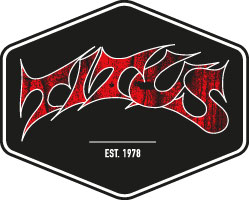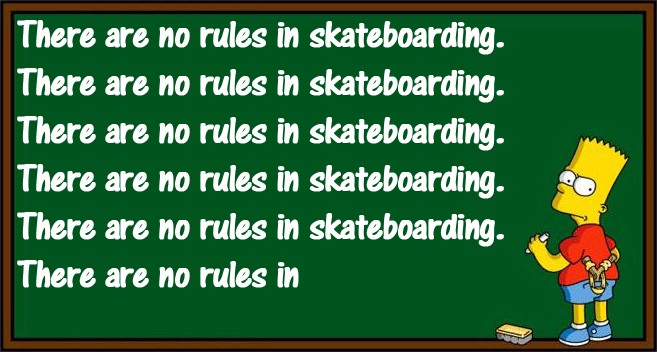
10 No-Go´s in Skateboarding
In skateboarding, you can essentially do anything you want. You don’t have to train every day or answer to a coach, there are no boundaries, and the only real limitations are your own capabilities. Well, at least that’s how it was when I started skating in the summer of 1989.
Today, skateboarding still offers incredible freedom, but there are several “unwritten rules” found throughout the skate community. Some of these “rules” are regarded so highly that many skaters may deem them “career critical”, that is, if you were looking to become a sponsored or even professional skater. So, what could one of the most tolerant communities of people in the world possibly think is unacceptable? Here’s a list of skate “rules” you might want to consider before your next session.
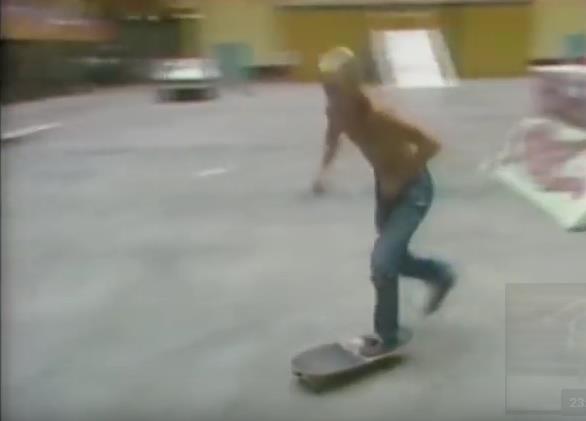
#1: Mongo Pushing
In the late 80’s, skateboarding was pretty much a free-for-all. If you look at contest videos from this era, “Savannah Slamma” for example, the runs and trick selection may seem laughable by today’s skate standards. The difficulty of the tricks was considerably lower, with the exception of a few star skaters like Natas and Mark Gonzalez. However, there was one skater in particular whose style set him apart from the crowd, Bill Danforth. The bald-headed Alva Skateboards pro often pushed with his leading foot, a trend that skaters today would call “mongo pushing”. Bill was actually so known for this that skaters began referring to it as “pushing Dan”, among the many other terms such as “stupid footed”, “piss pedaler” or “rear wheel drive”. If there’s anything skaters are picky about, it’s the style and aesthetics that go with skateboarding – let’s be honest, pushing mongo just doesn’t look good.

Fun facts:
- There’s a major caveat when it comes to pushing mongo, the switch mongo push. Legends like Eric Koston and Gino Ianucci are perfect examples of skaters who push mongo when skating switch, and it has become an integral part of their super steezy skate style.
- If you’re already guilty of pushing mongo, no worries, some of your favorite pro skaters began skating that way! There’s video proof of pros like Jason Dill, Tom Penny, and others in their early years pushing mongo. Actually, if you’ve ever noticed that Andrew Reynolds sometimes throws his board down to set up for a trick with the opposite hand as usual, this is a habit from the early days of being a mongo pusher!
- As a skateboard trainer in Sudan, Samuel Beyer made it a point to teach his students not to push mongo from their very first push. Even in the Sudanese capital of Khartoum, kids must learn this important style-element of skateboarding!
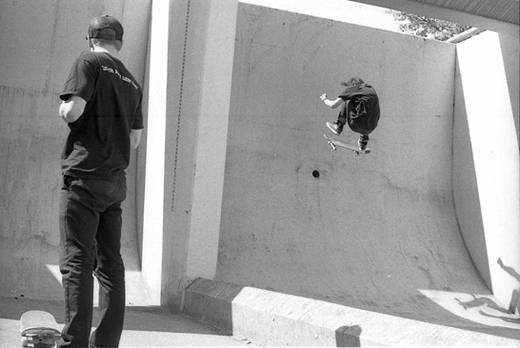
#2: "One-Upping" another skater
Imagine you are at your local spot and you think of a new trick to try on the ledge. You’ve got noseslides on lock, so you decide to try to add a nollie heelflip out of the slide. So, you start trying it and several hours and seemingly countless tries later, you still haven’t landed it. Suddenly, “Johnny Skater” rolls up to the spot, sees you trying the trick, and busts out a perfect noseslide nollie heel out across the whole ledge. In skating, this is practically the equivalent of giving another skater the middle finger. Skating at its core should not be a competition; it should be about having fun with friends and encouraging others. If anything, give another skater some tips to land their trick if you know how to do it. Showing up others to prove how good you are just sucks, whether in skateboarding or in life!
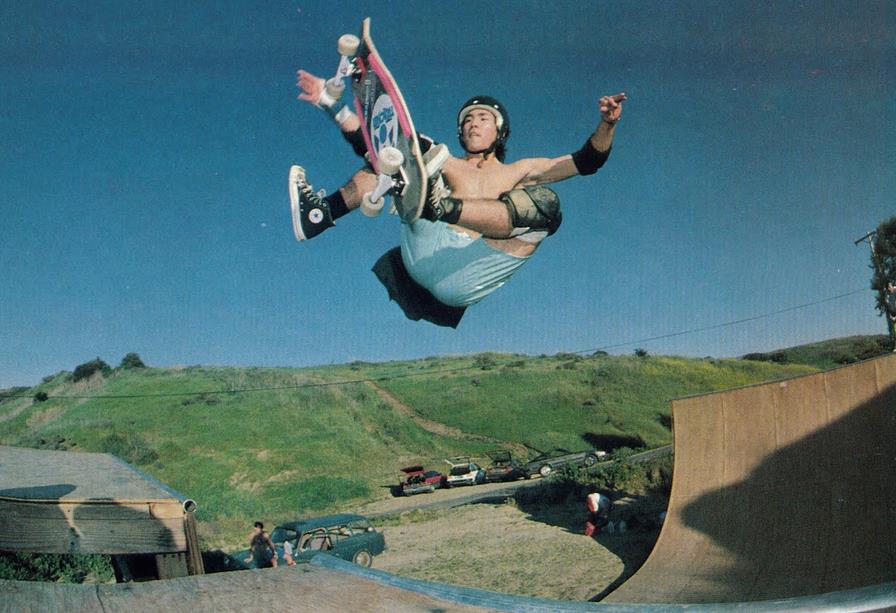
#3: Benihanas
For whatever reason, many tricks have earned a reputation that deems them “ugly” or “uncool” in the skate world. Of course, it’s up to you to decide what you think looks good and what doesn’t, but there are some tricks that most skaters would generally agree on as looking pretty silly. Dolphin/forward flips, front foot impossibles, and willy grinds are all tricks with an ugly reputation, depending on how they’re performed, but one trick takes the cake when it comes to weird: the benihana. This trick has earned celebrity status for its negative image. It was first invented by Lester Kasai, who named the trick after the Asian restaurant chain, Benihana! The trick is done in the air and it involves removing your back foot from the tail while simultaneously doing a tailgrab, sometimes even touching your crotch, causing you to spread your legs all the way apart into a pretty ridiculous form. Christian Hosoi was known for doing benihanas while doing a frontside air on vert, coining his own term for the trick, the benibonga! One of the first “known” street benihanas was done by John Cardiel in 1991, where he did it down the EMB “big 3” in his Dogtown video part. Shortly after, the trick began being known as a “circus trick”, as skaters like Josh Kasper started popping them off curb-cuts and jump ramps. Nowadays, it is a typical quarterpipe-to-platform trick performed by the local skatepark hero. As Clyde Singleton said in a Transworld interview 10 years ago, “what the hell'd make anyone take their back foot off their skateboard midair and grab the tail?”
Fun facts:
- Jamie Thomas does a benihana in his Toy Machine “Welcome to Hell“ video part (1996), which was sort of the last benihana to be found in a “serious” video part.
- Sometimes in skate contests (at least in Germany), a skater doing a benihana in their run can actually lead to a point reduction. This is because style is calculated into the point evaluation and this trick is not usually associated with style.
- The reputation that certain tricks have certainly changes over the years. Some great examples are varial flips, late shuv-its, and pressure flips, which have all gone through periods of being “uncool” but have since returned to become respected tricks done by many pros.
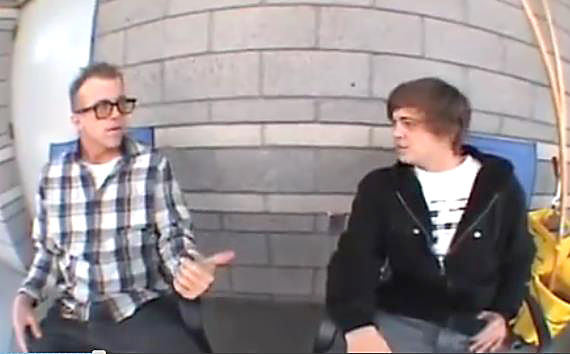
#4: Claiming tricks you´ve never actually done
Nowadays, this point is even a little outdated because of the likelihood that someone will always have a phone ready to film the trick. Regardless, it goes without saying that it’s just super lame to lie about doing something that you didn’t, especially when it’s a gnarly skate trick. Back in the day, there are several instances where pro skaters lost a ton of respect for doing exactly this. In an “epicly later’d” episode with Heath Kirchart, he calls out skater Jerry Fowler for what Heath thinks was a lie. Heath takes credit for being the first skater to skate the famous El Toro rail, but at the time, Jerry (a purely ledge skater at the time), told him that he had already done a noseslide down the rail but didn’t have a camera to film it. This is ridiculous because it would have been a career changing trick for Jerry, if he had filmed it. The same goes for Ryan Sheckler during an interview with Thrasher’s Jake Phelps. When Shecks was asked if he backside flipped El Toro, he responded with a loud and clear “YES”. It’s speculated that Ryan had at least attempted the trick several times while filming for Plan B’s “True” video, but not yet landed it. Instead, Sheckler said he did it out of sheer confidence that he would soon do it, but failed to actually do so. We’re still waiting for the backside flip footage to this day.
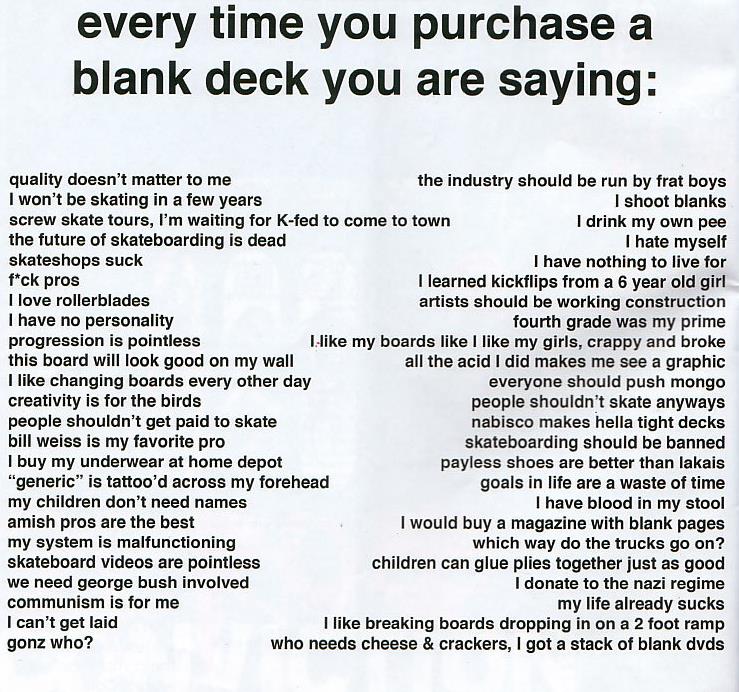
#5: Blank Decks
Around 10 years ago, a trend emerged that actually threatened the livelihood of the skate industry as we know it – blank decks. These decks shook up the industry so badly mainly because of their impact on pro model deck sales by established board companies. It’s difficult to say exactly when and where blank decks first started arriving, but the trend was blowing up around the turn of the millennium. As the name suggests, the decks have no graphic printed on the bottom and the only company involved in production is a woodshop, most likely based in China. Of course, the decks could be sold significantly cheaper than a pro model deck from a recognized brand at the time like Real Skateboards. Blank decks had no skate team, no magazine ads, no skate tours, and no promo videos. Even though it sounds pretty lame, it was actually a very profitable business at the time. Unfortunately, the deck manufacturers had absolutely nothing to do with skating and were just cashing in on it. However, these blank companies soon pushed it too far by reducing the quality of the decks to cut costs. Skaters realized that there was a significant quality difference between blanks and pro boards shortly after, and the issue sort of leveled itself out as skaters gained preference again for pro decks (with the exception of really broke skaters who just needed something to ride). Today, even the well-known brands now do their best to cater to price sensitive groups by offering “price-point” decks at a slightly reduced rate. Which is good for everyone as even budget skaters can help support the skate industry.
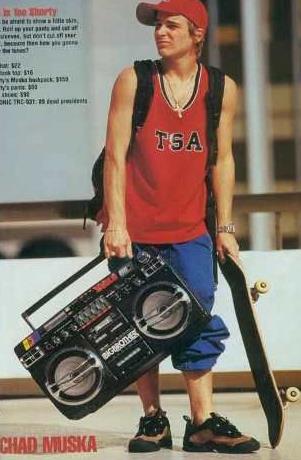
#6: Skating with headphones on
Music and skateboarding have always gone hand in hand. The sound of a high-speed slasher grind on pool coping or a long grind on a marble ledge never gets old, but it’s certainly enhanced by some decent background music. Back in the day, Muska was known for toting around his gigantic boombox to amp up the sesh at every skate spot he went to. Nowadays, we live in a different era where everyone has a phone and every phone comes with a set of headphones. While this is good from the viewpoint of the skater himself, this can be really annoying for the skaters around him. Many skaters know the feel of playing a game of skate with someone wearing headphones. It probably went something like this; “Was that switch or regular?” “Huuuuh?!?!” “Was that fakie or nollie” “Whaaaaat?!?” as the other skater continually puts his earphones in and out to listen. You can’t argue that skating is an individualistic sport, but let’s face it, there’s nothing better than an awesome session with your homies, and you should be able to hear them! Luckily for us, nowadays there’s a huge selection of portable Bluetooth speakers. So just like the Muska era, you can easily bring a speaker with you and bump all your favorite songs at the spot for everyone to enjoy.

#7: Don´t be an asshole
It goes without saying that being an asshole usually never gets you far in life, so why would it be any different in skateboarding?! Still, when told to leave a spot or skate someplace else by security or passers-by, some skaters resort to treating them with sheer disrespect. Take this example, you’re skating a set of stairs and the building security guard walks up and politely (or rudely) asks you to leave. No matter what he did, if you respond by telling him to f**k off and trying to keep skating, he’s almost certainly going to get pissed and call the police. Now, let’s say you respond by politely explaining that you’re trying to film a trick, you don’t want to destroy or harm anything, and then you will leave. In the second case, the security guard is exponentially more likely to say “okay, but just one or two more tries!” Also, if you are confrontational, it’s very likely that the guard will report the case and you will soon find that the spot has been skate-stopped with knobs on the rails or ledges, effectively ruining the spot for every other skater. More so, when you are skating in public, if you get pissed and start freaking out, throwing your board, screaming, etc., you are portraying a super shitty image of skateboarders as a whole to everyone in the area. The same goes with leaving garbage at the skate spot, it’s all common sense, and you always owe it to every other skater to portray a positive image of the sport that you love so that the skate scene continues to thrive.
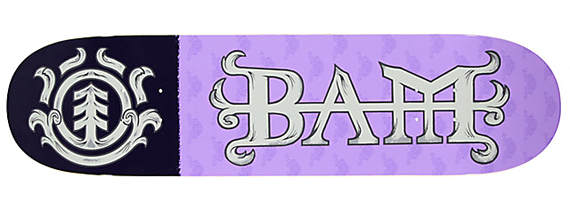
#8: Just because you own a skateboard, doesn´t make you a skater
You might be asking yourself, “who buys a board but doesn’t even skate it?“ Actually, you might be surprised at just how many people do! It’s not the same as someone buying sports equipment and then not using it. Skateboarding isn’t just a sport but rather a lifestyle complete with pro skaters who are sometimes even viewed as celebrities outside of skating. The greatest example of this is Bam Margera. In his recent interview with Chris Roberts on "The Nine Club", Bam explains that his pro model decks were selling upwards of 40,000 units per month in their heyday. The amount of these boards that were actually skated remains unknown, but what is known is that Bam had an insane amount of fans from his hit MTV show, many of which were young girls who never set foot on their Element decks. In the late nineties when the first “Tony Hawk’s Pro Skater” game hit the market, there was a drastic spike in complete skateboard sales shortly after. It can be easily assumed that this was due to so many kids loving the game and wanting to try the tricks in real life. When all these kids realized how much harder it was to do a kickflip in real life, they returned to gaming on the couch and their World Industries completes ended up in the basement for years to come. So, would you approve of someone saying they are a skater because they own a deck or had skated one or two times? I’m not sure I would.
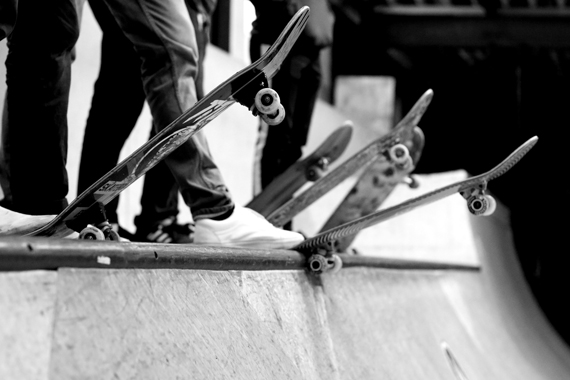
#9: Don´t be a snake
As we grow older, our bodies naturally get more fragile and susceptible to injury. There are only a few superhuman skaters to this day who are over the age of 35 but still jump down huge sets of stairs. At some point when you get older, you’ll probably discover the love of mini-ramp skating. Beware; when you step onto the mini-ramp, you are sometimes also stepping into a snake pit! Often times, little kids just don’t know how it works, but when you’re on the mini ramp, ready to drop in with your board on the coping, and suddenly another skater flies into the ramp infront of you, it sucks! It’s especially bad when that skater then begins a seemingly endless line of axle stalls on the ramp before sliding to a stop on the flat bottom on his oversized pair of kneepads. Have courtesy for other skaters, especially in a skatepark or mini ramp! Luckily, this instance is usually less common at skate spots, where skaters generally understand that the session is somewhat turn-based.
Fun facts:
- At mini ramp contests, such as those presented by Vans or Volcom, it’s possible that the whole event can only be skaters snaking one another. However, this is usually also a party with beers and music, and snaking is totally acceptable. In this case, it can heat the session up even more and make it that much more wild.
- In the 90’s, there were several popular skate crews around Germany. One of them was known as “Die Macht” from the Ruhr region. Their crew included legends like Mussa, Fadi Najras, Mehmet Aydin, Flo Marfaing, and a few others. When this crew skated contests, they had a reputation of being a dangerous crew if you got in their way. A great example is Mussa during a contest at the Keuninghaus in Dortmund. Another skater blatantly got in his way during the contest, so he smashed the skater’s deck on the spot!
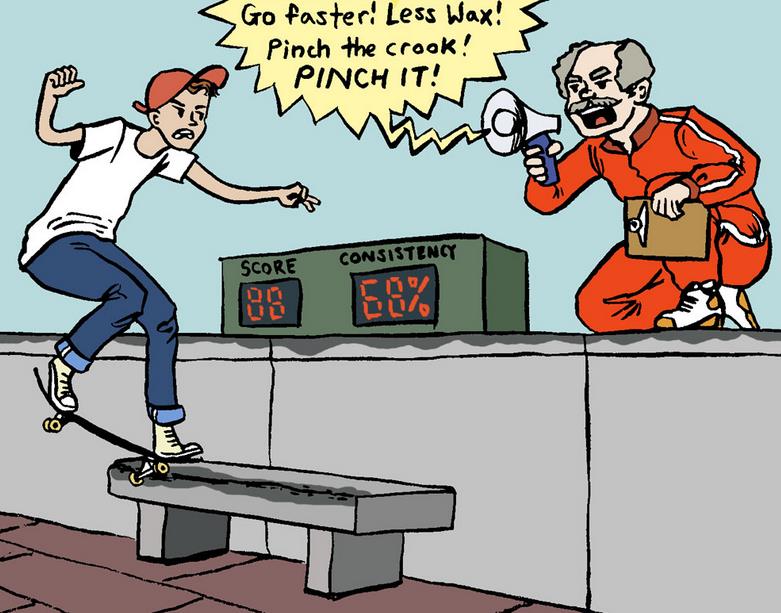
#10: Training
The word “training” is directly associated with competitive sports. The Collins Dictionary defines training as: physical exercise that you do regularly in order to keep fit or to prepare for an activity such as a race. I’m not sure about you, but that doesn’t really sound like having fun skateboarding with your friends. If you showed up to a skate spot with this intention, the other skaters would probably get bummed out pretty quick. This is because skateboarding was never about being “the best”. More importantly, it’s actually impossible to be the best skateboarder. That’s because every skater has their own style and whether someone skates good or bad is purely subject to personal opinion. Even so, skateboarding is soon coming to the Olympics, which are grounds for incredible debate within the skate community. However, there’s no denying that it’s a little weird for a skater to answer to coach yelling at him to skate faster or pop higher. In the end, it really is all about fun. If it’s fun for you to be forced to practice every day, that’s on you.
Fun fact:
- Many of today’s Street League stars like Nyjah Houston, P-Rod and others have their own private skatepark specifically for training. Nyjah was even quoted in a Thrasher interview for saying, “I wish there would be more contests in skating. I would be down to skate one every week if I could”. Some skaters just thrive on competition, and that’s okay, but even if you win every contest, it doesn’t mean you are the best. Nyjah wins many and he’s a super gnarly street skater, but even then, many skaters would still disregard him for his style, trick selection, practically anything. It’s all subjective. In the end, what really matters is having fun, whatever that means to you!
"Must have" articles at titus:
Es ist ein Fehler beim Laden der Produkte aufgetreten:
